Rich running and burned out ECU
Discussion
I was going to post to see what people thought would cause this problem:
- car starts perfectly, then runs really rich without obviously misfiring and is hard to get moving under low throttle
- seems to run fine at speed, but runs really poorly and can conk out when trying to pull off
- Rover guage was showing long term trim at -100% and short term going from 0 to -100% when touching the accelerator (nothing else obvious showing as a problem that I could tell). Revving high shows short term improving to -30% ish
- tried a spare MAF, no change
I then started poking about randomly checking connections, pulled the ecu and saw this burned out component. And some of the connections have green furring on them.
I have a few questions(!);
-What do you think has happened here, would this cause the symptoms above or be a further symptom of the problem? (i.e if I get a replacement ecu will that pop too)
-Also is this repairable or is it junk
-does it look like a standard chip? (its a 96 500 serp)
Thanks for any help!
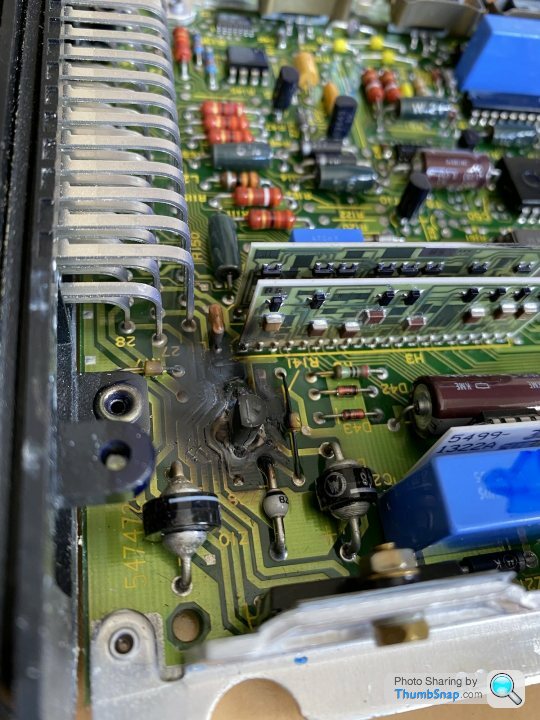
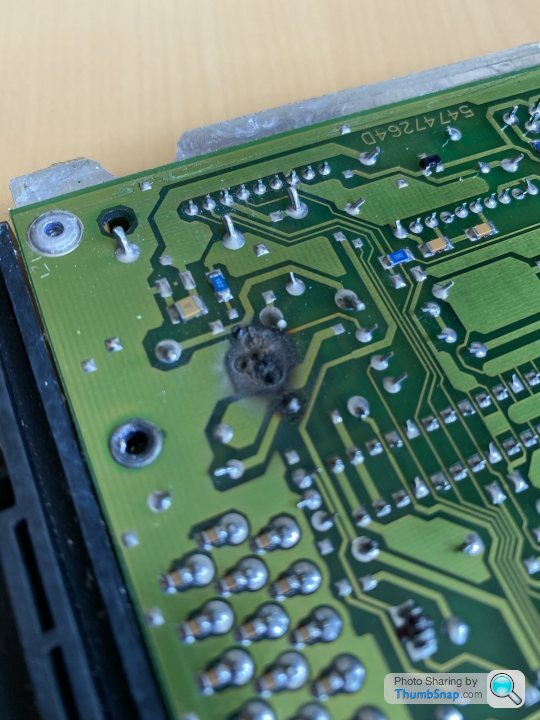
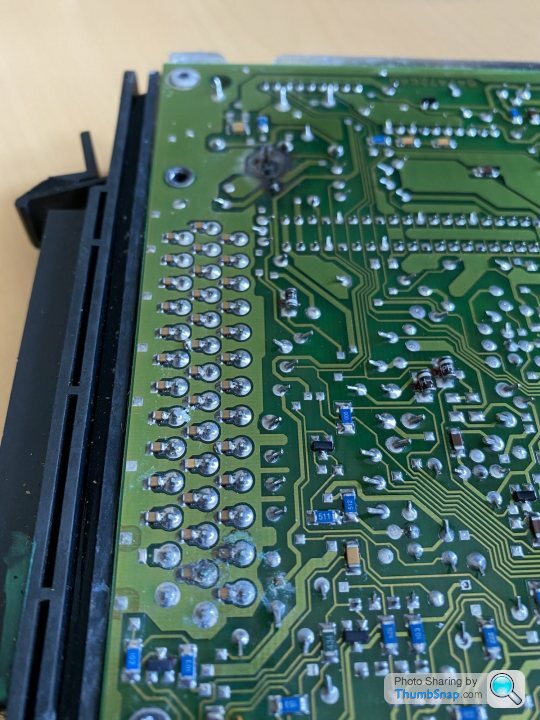
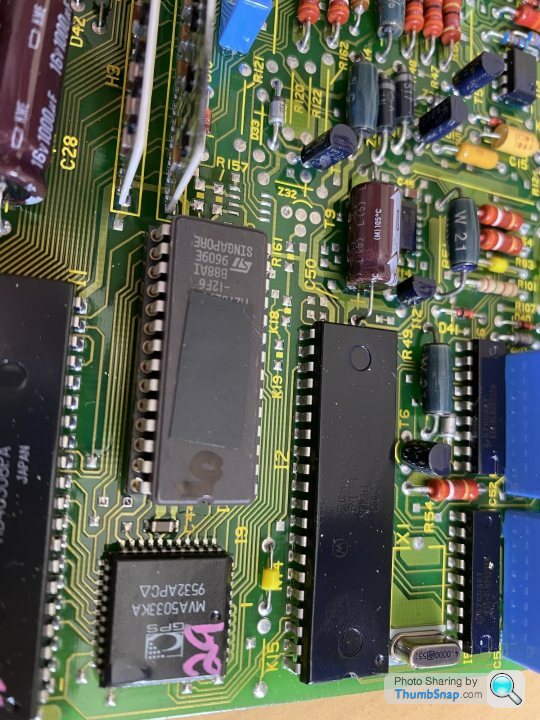
- car starts perfectly, then runs really rich without obviously misfiring and is hard to get moving under low throttle
- seems to run fine at speed, but runs really poorly and can conk out when trying to pull off
- Rover guage was showing long term trim at -100% and short term going from 0 to -100% when touching the accelerator (nothing else obvious showing as a problem that I could tell). Revving high shows short term improving to -30% ish
- tried a spare MAF, no change
I then started poking about randomly checking connections, pulled the ecu and saw this burned out component. And some of the connections have green furring on them.
I have a few questions(!);
-What do you think has happened here, would this cause the symptoms above or be a further symptom of the problem? (i.e if I get a replacement ecu will that pop too)
-Also is this repairable or is it junk
-does it look like a standard chip? (its a 96 500 serp)
Thanks for any help!




Hard to tell without a schematic diagram, but it's obviously a fried transistor and looks to be part of the supply circuit for the Stepper Motor (pin 1, ECU Connector) or MAF/Main relay (pin 2).
Check using RoverGauge to see if the stepper motor is working correctly, and that it's associated wiring is all good.
Repairable, possibly. Component availability may be a problem. I would get a replacement ECU and swap your EPROM chip over.
Check using RoverGauge to see if the stepper motor is working correctly, and that it's associated wiring is all good.
Repairable, possibly. Component availability may be a problem. I would get a replacement ECU and swap your EPROM chip over.
Edited by davep on Sunday 11th April 14:18
DaveP is right - 14 CUX ECUs are readily available from people who have upgraded their ECUs, or from the garages that do the upgrades. Anyone can swap the eprom over (well, anyone can if I managed to change mine over after my old one failed). The ECU is just a standard LandRover item, and you already have the correct chip in yours. It is clearly marked with the engine size in marker pen. Here's one I found in 10 seconds on Ebay, for example:
https://www.ebay.co.uk/itm/LUCAS-14-CUX-ECU-for-Ro...
Green furring could be battery acid or water ingress. The ECU case is not fluid proof. The ECU is often sited next to the battery, and if the battery overheats and boils then acid ends up on the carpet against the side of the ECU. It's the reason my car suddenly stopped working one Friday evening, as my TVR expert diagnosed the next day ("It MUST be the ECU"). Luckily I not only had a spare ECU, just with the wrong eprom, but I had taken it with me to said expert. The car ran (rough) with the wrong eprom. Quick change over of eprom and we were up and running smoothly again. The fueling chip in my case had been eaten away by acid.
https://www.ebay.co.uk/itm/LUCAS-14-CUX-ECU-for-Ro...
Green furring could be battery acid or water ingress. The ECU case is not fluid proof. The ECU is often sited next to the battery, and if the battery overheats and boils then acid ends up on the carpet against the side of the ECU. It's the reason my car suddenly stopped working one Friday evening, as my TVR expert diagnosed the next day ("It MUST be the ECU"). Luckily I not only had a spare ECU, just with the wrong eprom, but I had taken it with me to said expert. The car ran (rough) with the wrong eprom. Quick change over of eprom and we were up and running smoothly again. The fueling chip in my case had been eaten away by acid.
If that part of the board is as davep says then I would be checking the wiring loom for a possible short to ground even intermittent on any of the mentioned components with a 12v + supply , check ECU mainplig for water ingress etc too , even if you seen green/corrosion your onto an issue
Be aware that the earlier 14CUX ECU's did not have a socket for the EPROM, so interchanging the EPROM is not straightforward. These early ECU's require the addition of a socket, not difficult but a bit fiddly if you do not have experience of soldering small components. No doubt DaveP or Blitz will know when the date that the later ECU' with a socket appeared. The date is clearly visible on the ECU outside case.
As above, the most important thing is to try to understand why this has happened. Transistors rarely just blow so I'd suspect power has been applied incorrectly, either because of corrosion/shorting or maybe even if the battery has been connected the wrong way around at some point?
The board itself is likely to be repairable, but you will need to identify and replace the destroyed tracks on both sides of the board with wires, plus, of course, replace the transistor. Other components could have been damaged too. I doubt there will be any markings left on the transistor on the board so you'll need either to look at another ECU, find a circuit diagram or get someone with a similar car to take a look in their ECU to get the transistor part number. I suspect you'll find they will still be available. This is all quite a lot of faff, so I suspect a replacement ECU may well be your best solution as others have said, unless you are handy with electronics and soldering!
The board itself is likely to be repairable, but you will need to identify and replace the destroyed tracks on both sides of the board with wires, plus, of course, replace the transistor. Other components could have been damaged too. I doubt there will be any markings left on the transistor on the board so you'll need either to look at another ECU, find a circuit diagram or get someone with a similar car to take a look in their ECU to get the transistor part number. I suspect you'll find they will still be available. This is all quite a lot of faff, so I suspect a replacement ECU may well be your best solution as others have said, unless you are handy with electronics and soldering!
gavgavgav have you changed the injectors on your car recently?
Looking at the burnt out transistor's location again it could be part of the output switching circuit for the injector banks.
So it may be worthwhile checking the injector wiring and the injector resistance values prior to fitting a replacement ECU.
If you have changed injectors what type did you fit?
Postscript...
I've now checked a spare ECU and I'm pretty sure the zapped transistor (PN3634) is part of the internal voltage regulator circuit, what's puzzling though is the ECU still continues to function!
Looking at the burnt out transistor's location again it could be part of the output switching circuit for the injector banks.
So it may be worthwhile checking the injector wiring and the injector resistance values prior to fitting a replacement ECU.
If you have changed injectors what type did you fit?
Postscript...
I've now checked a spare ECU and I'm pretty sure the zapped transistor (PN3634) is part of the internal voltage regulator circuit, what's puzzling though is the ECU still continues to function!
Edited by davep on Monday 12th April 15:14
Thanks for all the advice so far, been really helpful. Just to share what I've done so far as I've been working slowly through it. I've cleaned up the board to try and see and trace the circuit tracks which is a little difficult, below are a couple of pics with the transistor removed, I've tried to google what T7 is used for but can't figure it out. The remaining readable letters suggests the transistor it the same as the others of that size (S3643).
Tested so far;
- Throttle pot (which starts at 11.5K ohms at rest then goes down OK, which seems high)
- Stepper motor, 52 ohms on both sides.
Note that on Rover guage the screen seemed to be showing that these components were OK, and I could hear the stepper moving about on demand.
Thanks for the idea - I'll test the Injector wiring and earth straps too. They injectors are the originals and not been removed since the car new. Now I've totally removed the transistor (it had no solder left on 2 connections). I'm thinking of plugging the ecu back in and see what does not work. I will check the AFM next as well.
If anyone does have a spare about (ideally with a port already there) please do reach out, I'm about to buy one off eBay otherwise
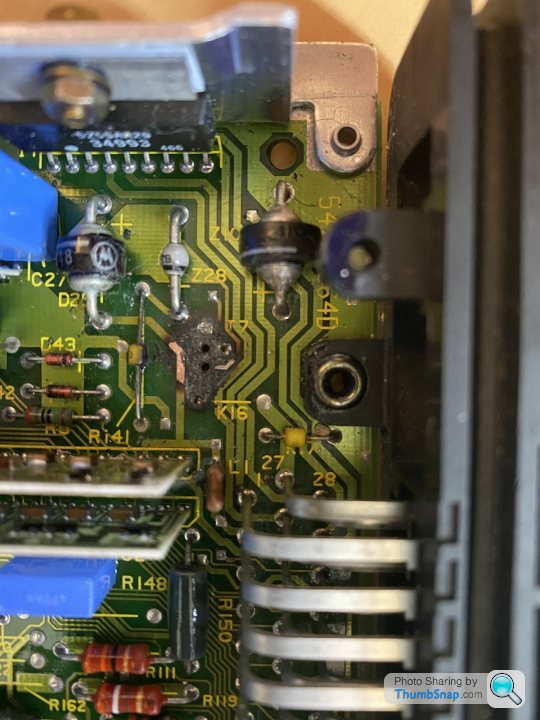
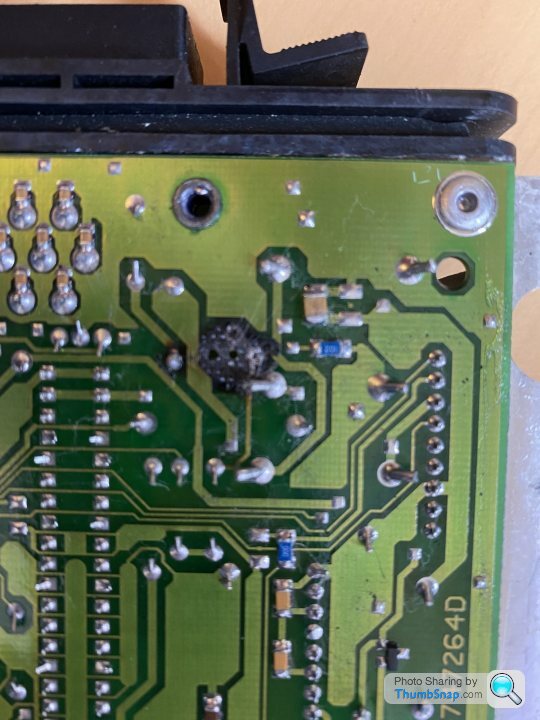
Tested so far;
- Throttle pot (which starts at 11.5K ohms at rest then goes down OK, which seems high)
- Stepper motor, 52 ohms on both sides.
Note that on Rover guage the screen seemed to be showing that these components were OK, and I could hear the stepper moving about on demand.
Thanks for the idea - I'll test the Injector wiring and earth straps too. They injectors are the originals and not been removed since the car new. Now I've totally removed the transistor (it had no solder left on 2 connections). I'm thinking of plugging the ecu back in and see what does not work. I will check the AFM next as well.
If anyone does have a spare about (ideally with a port already there) please do reach out, I'm about to buy one off eBay otherwise



gavgavgav said:
If anyone does have a spare about (ideally with a port already there) please do reach out, I'm about to buy one off eBay otherwise 
Contact spitfire4v8 (Kits and Classics) who has a number of known good ECUs on the shelf, taken from TVRs. 

spitfire4v8 in another thread said:
When i do my emerald ecu conversions I do a part exchange where i essentially allow the customer 300 pounds part exchange allowance for all their lucas parts .. ecu, airflow meter, distributor, coils and amps, leads, extenders, cap and rotor arms, stepper motors etc etc
What it means is that I have a stock of items I know have come off fully working cars ..
What it means is that I have a stock of items I know have come off fully working cars ..
Contacted Joo thanks 
Tested the injector banks, both at around 45 ohms, also checked the engine earth strap and looks ok. ECU plug remarkably clean and corrosion free too.
Decided to plug it back in and fire it up to see what isn't working, and somehow it works with the transistor completely removed so that plan diddn't work, but is really rich and rougher than before at idle. Maybe its used to pulse the injectors properly or something like that (just guessing as I have no idea).
Did find something odd tucked in the wiring which looks like it could of been a earth strap at one time, really suspicious as it looks hacked about with bit cleanly cut, and I can't see where it would of connected or what it was for as its been cut at both ends. (note in the pics I had relocated the fuse from underneath the engine) I've had this car for 14 years at 20 K miles, no other mechanic has been near the engine to do this in that time. It's been running rough at idle/ low revs for about 300 miles or so, which makes me think it's not the problem. What do you think?
Bottom where I pulled it down as it was tucked next to the engine earth connection
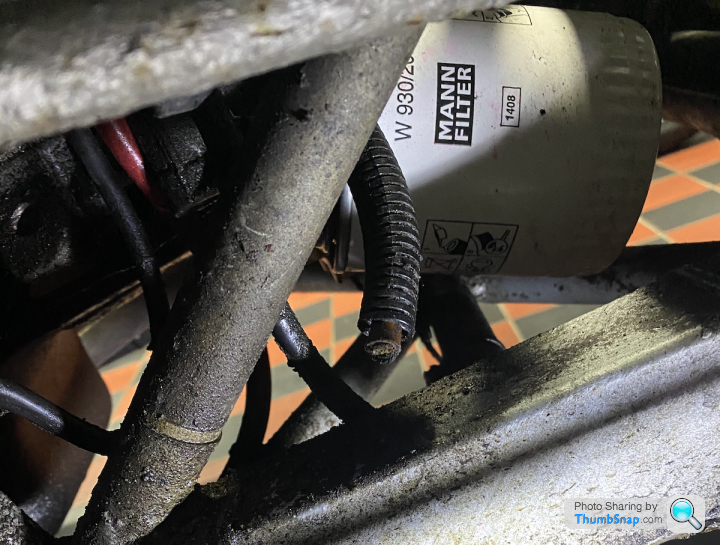
Top where I found the end after removing trunking insulation
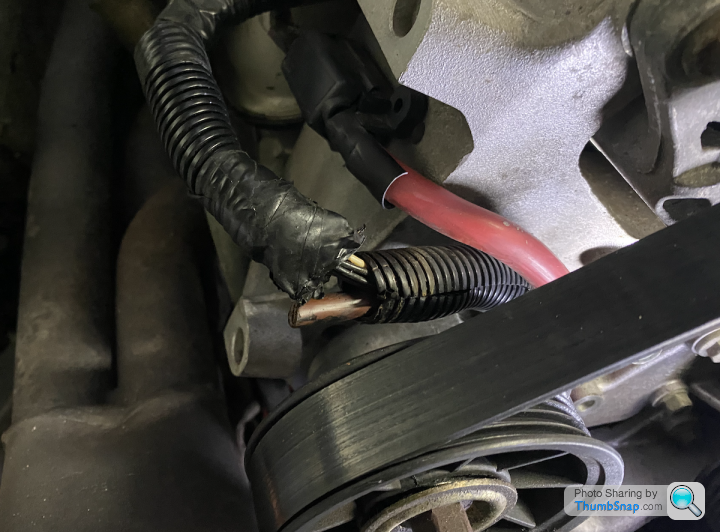
And after stripping the loom back a bit it looks likes it goes nowhere!
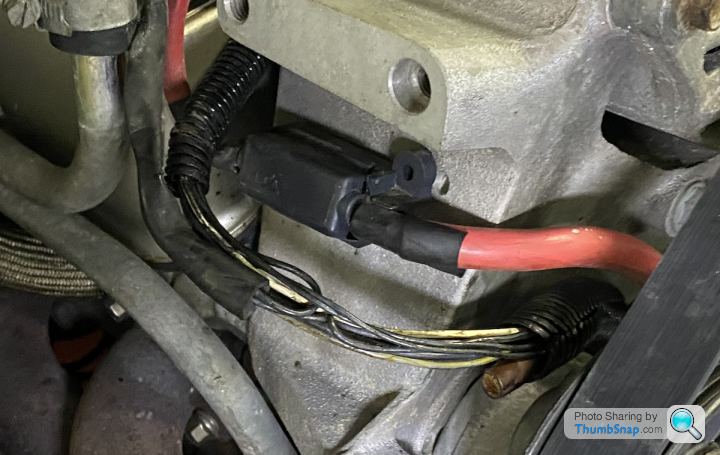

Tested the injector banks, both at around 45 ohms, also checked the engine earth strap and looks ok. ECU plug remarkably clean and corrosion free too.
Decided to plug it back in and fire it up to see what isn't working, and somehow it works with the transistor completely removed so that plan diddn't work, but is really rich and rougher than before at idle. Maybe its used to pulse the injectors properly or something like that (just guessing as I have no idea).
Did find something odd tucked in the wiring which looks like it could of been a earth strap at one time, really suspicious as it looks hacked about with bit cleanly cut, and I can't see where it would of connected or what it was for as its been cut at both ends. (note in the pics I had relocated the fuse from underneath the engine) I've had this car for 14 years at 20 K miles, no other mechanic has been near the engine to do this in that time. It's been running rough at idle/ low revs for about 300 miles or so, which makes me think it's not the problem. What do you think?
Bottom where I pulled it down as it was tucked next to the engine earth connection

Top where I found the end after removing trunking insulation

And after stripping the loom back a bit it looks likes it goes nowhere!

Edited by gavgavgav on Tuesday 13th April 11:36
Edited by gavgavgav on Tuesday 13th April 11:40
Just to follow up as I do hate it when people don't report back with an outcome, the car is running well now.
Following refreshment of engine earth lead, as everything passed whatever test was tried I then took the plunge and fitted the replacement ECU and it didn't blow the transistor. One thing I noticed when using roverguage what that the stepper motor was getting hot to the touch when the car was not running, and fitting a new one which does not get hot also has also seen improvement in idle behaviour. Maybe this was the culprit all along, or it was a rare case of a dodgy transistor.
Putting mileage on it now to see what happens.
On the upside while I was waiting for parts to arrive I took the opportunity to take the sump off, repaint it and reseal it. Now there are no oil leaks.
Following refreshment of engine earth lead, as everything passed whatever test was tried I then took the plunge and fitted the replacement ECU and it didn't blow the transistor. One thing I noticed when using roverguage what that the stepper motor was getting hot to the touch when the car was not running, and fitting a new one which does not get hot also has also seen improvement in idle behaviour. Maybe this was the culprit all along, or it was a rare case of a dodgy transistor.
Putting mileage on it now to see what happens.
On the upside while I was waiting for parts to arrive I took the opportunity to take the sump off, repaint it and reseal it. Now there are no oil leaks.
Gassing Station | Griffith | Top of Page | What's New | My Stuff




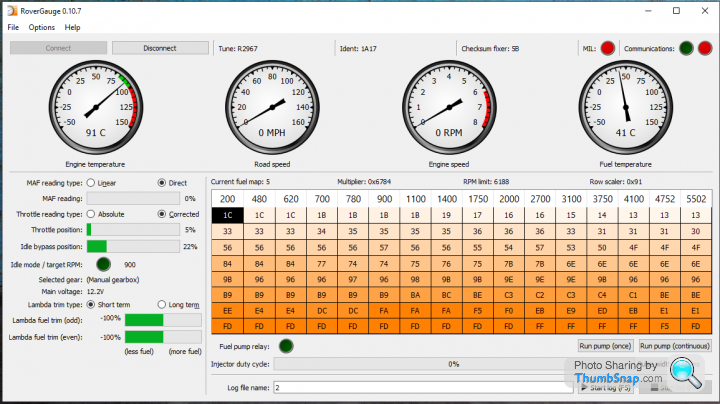

 that will kill the ECU in short order
that will kill the ECU in short order